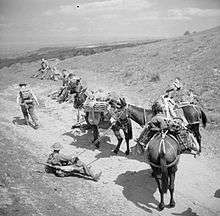31st Brigade (United Kingdom)
The 31st Brigade was an infantry brigade formation of the British Army in both World War I and World War II.
First World War
The 31st Brigade was originally raised in World War I in 1914 by volunteers from Kitchener's Army. During the First World War, it was assigned to the 10th (Irish) Division and served in the Middle Eastern theatre at Gallipoli, Salonika and Palestine.
Order of battle
- 5th (Service) Battalion, Royal Inniskilling Fusiliers (August 1914 – May 1918, transferred to 66th (2nd East Lancashire) Division)
- 6th (Service) Battalion, Royal Inniskilling Fusiliers (August 1914 – May 1918, transferred to 14th (Light) Division)
- 5th (Service) Battalion, Princess Victoria's (Royal Irish Fusiliers) (August 1914 – April 1918, transferred to 14th (Light) Division)
- 6th (Service) Battalion, Princess Victoria's (Royal Irish Fusiliers) (August 1914 – November 1916, absorbed by 5th Battalion)
- 2nd Battalion, Princess Victoria's (Royal Irish Fusiliers) (November 1916 – October 1918)
- 2nd Battalion, 42nd Deoli Regiment (July – October 1918)
- 74th Punjabis (April – October 1918)
- 2nd Battalion, 101st Grenadiers (May – October 1918)
- 38th (Service) Battalion, Royal Fusiliers (June – July 1918)[1]
Second World War

The 31st Infantry Brigade was reformed in World War II as an independent brigade group in the United Kingdom on 17 July 1940, composed entirely of Regular Army troops who had previously been stationed in British India.[2] On 26–27 September 1940 it was assigned to defend the Royal Military Canal, a few miles from Hythe and Dover on the south coast. There is a detailed description of this defence area in British archival survey sources.[3] At this time it appears to have been part of IV Corps, in South East Command.[4]
Order of battle
- 1st Battalion, Border Regiment
- 2nd Battalion, South Staffordshire Regiment
- 2nd Battalion, Oxfordshire and Buckinghamshire Light Infantry
- 1st Battalion, Royal Ulster Rifles
- 75th Field Regiment, Royal Artillery
- 223th Anti-Tank Battery, Royal Artillery
- 237th Field Company, Royal Engineers
and supporting units.[5] In late 1941, it had just returned to the United Kingdom after training for mountain warfare in British India.[6]
Under the command of Brigadier George Hopkinson, the brigade was redesignated the 1st Airlanding Brigade Group on 10 October 1941 (on 10 December 1941- IWM) and came under command of the 1st Airborne Division. 'It probably lost its unique badge at about this time although it did not lose its Group status until 10 March 1943.'[2]
On 15 April 1946, almost a year after the end of the war in Europe, the 6th Airlanding Brigade was renamed the 31st Independent Brigade.[7] This brigade wore a black desert rat on a red oval.[2]
Bibliography
- Joslen, Lt-Col H.F. (2003) [1960]. Orders of Battle: Second World War, 1939–1945. Uckfield: Naval and Military Press. ISBN 978-1-84342-474-1.
References
- ↑ "42nd (East Lancashire) Division". The Long Long Trail. Retrieved 16 January 2012.
- 1 2 3 Imperial War Museum,
- ↑ http://ads.ahds.ac.uk/catalogue//adsdata/arch-455-1/dissemination/pdf/Text_Reports/DA36_TEXT_-_ROYAL_MILITARY_CANAL.pdf
- ↑ http://www.ordersofbattle.com
- ↑ "31 Independent Brigade subordinates". Order of Battle. Retrieved 12 April 2011.
- ↑ Ferguson, p.6
- ↑ "31st Independent Brigade". Imperial War Museum. Retrieved 14 December 2013.